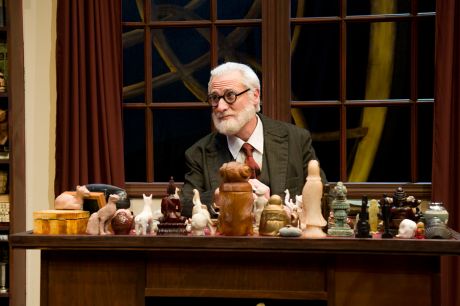Freudian Psychology
Freud Meets C.S. Lewis
Is history one great big repetition compulsion?
Posted July 26, 2014
This is a theater review by guest author, Merle Molofsky, who is a psychoanalyst, poet, playwright, and educator in New York City.
All photos by Josh Lamkin “FREUD’S LAST SESSION”

All photos by Josh Lamkin
“FREUD’S LAST SESSION”
Playwright Mark St. Germain has invented the most improbable, paradoxical, and delightful device, a time machine into an imaginary event, a meeting in 1939 at Sigmund Freud’s study in Hampstead, London, between Freud and the C. S. Lewis. His fantasy universe is enabled by his very able director, Tyler Marchant, scenic designer Brian Prather, costume designer Mark Mariani, lighting designer Clifton Taylor, and sound designer Beth Lake. “Freud’s Last Session” was performed at the Marjorie S. Deane Little Theater at the West Side YMCA in New York City.
The impeccably realized invocation of Freud and Lewis is perfectly embodied by actors Martin Rayner (Freud) and Mark H. Dold (Lewis). When the meeting takes place, Freud is 83 years old, in his last year of life, suffering from cancer, and Lewis 41. England and Germany are at a stand-off regarding Germany’s invasion of Poland.
St. Germain’s vision invites us into the socio-political universe of 1939, complete with an amazing reproduction of 20 Maresfield Garden, which itself was an amazing reproduction created by Anna Freud of her father’s study at Berggasse 19 in Vienna, so we are entering a universe of infinite regression, mirror images that might create psychological regression. His vision further presents us with two men who look, sound, speak and think so much like Freud and Lewis that when I saw the performance I forgot I was in a theater watching a show and felt like a fly on the wall, believed I actually was watching the “real thing”. The “real thing” is a powerful encounter between two oh so very different men, so very different in world view, age, religious background, cultural perspective, and yet so well matched as dueling intellects appreciating each other while vying for intellectual and spiritual survival.
St. Germain developed the idea for his play from a passage from The Question of God by Armand M. Nicholi, Jr. Dr. Nicholi is quoted in the playbill: “Did Freud and Lewis ever meet? The possibility is tantalizing. After Freud immigrated to England...(a) young Oxford professor visited Freud during this time but has not been identified. Might it have been Lewis?”
The sparring begins with both men on the defensive. Lewis arrives late, Freud is painfully aware that every moment of his life is now borrowed time, for illness consumes him. The bird of time is not just on the wing, it is soaring out of sight. Jofi, Freud’s dog, who is his almost constant companion, is barking, and interpretation begins with interpretation of Jofi’s absence. Freud describes Jofi as his “emotional barometer”, for Jofi stretches out at Freud’s feet when the patient is calm and stands alert and watchful if the patient is agitated. Lewis wonders uneasily why Jofi ran away from him, and Freud jokes pointedly that Jofi is a stickler for punctuality.
Jofi is a Hebrew word meaning “beauty”, and in modern Israeli vernacular is a word of approbration, like “chevere” in Spanish -- it could be translated as “dynamite”, or “way kewl”, or “great”. So from their first encounter in the first scene, Freud’s Jewishness is subtly alluded to, as Jofi is his Jewish soul’s barometer during the trying times of the Reich. This is further corroborated when Lewis compliments Freud on his view from the window onto a lovely garden and Freud responds, “The garden, yes. When I looked out my window at home I saw only Nazis burning my books.”
St. Germain therefore is able to use the accident of Jofi’s name, the name Freud chose for him, to frame for us the beauty of debate about the existence of God and the search for what is hidden. Both Freud and Lewis explore the hidden, Freud the unconscious and Lewis the hidden face of God in a world maddened by war and devastated by death.


Although he has been publishing books, Lewis at age 41 has not yet written his famous works celebrating Christianity, or his children’s books with their symbolic Christian references. He still is a man in search of his vision and his voice, a serious scholar and one time atheist who at the age of 33 had a cathartic, St. Paul-like conversion experience. As their meeting unfolds on stage, Lewis brings up his recent book that has material satirizing Freud, and they immediately are drawn into battle, not because Freud is sensitive about being satirized -- Lewis has a character in his book named Sigismunde Enlightenment -- but because at a time of world-shattering political upheaval and war, world-view matters. They are eager to butt heads.
Lewis is eager to defend a God-powered world, and to assert that a believer in God is not neurotic. Freud is eager to explore the meaning of fantasy, and is fascinated by the emergence of Lewis’s beliefs, and Lewis’s milieu of intellectual fantasists, the Oxford-based group calling themselves “Inklings”, which included Tolkien.
I emphasize the cultural underpinnings and historical context of the great debate and incipient friendship developing between these two men in the beginning of the play to underscore the compactness and rich allusiveness of St. Germain’s writing. He sets the stage both literally, bringing us into Freud’s study so convincingly that we believe we actually are there, and metaphorically, setting the world stage and the world of ideas as these two men of such different traditions find each other a challenging alter ego. In a certain sense we are witnessing an in-depth encounter that parallels the brilliant short story by Jorge Luis Borges, “The Theologians”.
“The Theologians” begins with ruination, as the Huns sack a monastery, destroy its garden, and burn its books, paralleling Freud and Lewis’s initial dialogue about a beautiful garden and the Nazis burning Freud’s books. Two third century A.D. theologians, Aurelian and John of Pannonia, are vying for the minds of Europe. The first paragraph describes a heretical belief in the wheel of history, that history is eternally cyclical and that there is nothing that has been and will not be. Is literary history repeating itself, with Borges pitting the Emperor Aurelian against John of Pannonia, while St. Germain pits Freud against Lewis?
The battle between the theologians focuses on the nature of history, particularly on the notion that history is in effect one great big repetition compulsion. The story concludes thusly:
The end of the story can only be related in
metaphors since it takes place in the kingdom
of heaven where there is no time. Perhaps it
would be correct to say that Aurelian spoke with
God and that He was so little interested in religious
differences that he took him for John of Pannonia.
This, however, would imply a confusion in the
divine mind. It is more correct to say that in
Paradise, Aurelian learned that, for the unfathomable
divinity, he and John of Pannonia (the orthodox
believer and the heretic, the abhorrer and the
abhorred, the accuser and the accused) formed one
single person.
Both Freud and Lewis believe in something they find beautiful, and the “one soul” quality of what they find beautiful is what Hitler is attacking. They both love the life of the mind, but Freud sees belief in God as something that despots can manipulate, that they learn from history and repeat history, invoking God to justify their evil acts, while Lewis sees evil acts as something God uses to awaken conscience. As they offer each other their own beliefs, they begin to talk about their fathers, their childhoods, a bond grows between them, and the theological argument continues. Freud’s line of questioning is an eerie combination of a genuine analytic stance, leading Lewis to examine his childhood fantasies regarding his father, and a belligerent, sardonic challenge of Lewis’s most cherished ideas. An air raid interrupts their cordial yet deadly serious quarrel, and when “all is clear” they wind up overcoming their mutual fear with jokes, very much in keeping with what Freud addressed in “Humor and the Unconscious”.
Thus St. Germain imagines for us an encounter that perfectly illustrates the Oedipal foundation of psychoanalytic thought. They are joined in a father and son dyadic struggle, each unwilling to yield to each other.
The debate over the existence of God opens into an exegesis of good and evil, and the mystery of pain and suffering, the struggle between revelation and science. But it does not stay there. We are, after all, in Freud’s study, and Freud is at heart a Freudian. They begin to talk about sex, Lewis complaining that due to Freud we replaced what essentially is repressiveness regarding talking about sex to preoccupation and obsession with talking about sex. Freud is undaunted, and, still recovering from the scare of the air raid siren and the increasing pain of his cancer-riddled jaw, begins an exploration of what he suspects is Lewis’s interest in an older woman with whom he lives, the mother of a deceased army comrade. Lewis becomes incensed, wards off Freud’s inquiries, and Freud says, “...I always consider what people tell me less important than what they cannot”.
Lewis turns the tables, beginning by asking Freud about a photograph of Freud with his daughter Anna. As Lewis presses on, rather brilliantly, an analyst in the making or an analyst manqué, Freud grows uneasy, and evasive, much as Lewis had, and Lewis says, “What people say is less important than what they cannot”. The two souls are indeed becoming part of each other.
The play culminates in a medical emergency, in which Lewis assists Freud. As the medical crisis subsides, transport planes are heard overhead, and the question of life and death, which was woven in and out of the dialogue about the existence of God, comes to the fore. Freud faces the existential reality of his own death with consistent courage, and Lewis faces it with him.
I found the experience of watching this play extraordinary. I was invited into a passionate dialogue between two very different men, both passionate, each committed to a belief system that was antithetical to the other, and both who in the passion of their intellect attracted followers. The two actors achieved what great acting should; they were “merely” being. Rayner was Freud, Dold was Lewis, and there never was a sense that I was watching a depiction of reality. Whether or not one believes in God, whether or not there is a God, whether or not I was watching actors acting in a play, Freud and Lewis were in a room, discovering a kinship, transcending their Laius-Oedipus destiny in their intellectual struggle and becoming, for the brief time they could strut on stage, before either of their candles sputtered out.
St. Germain himself has a prodigious intellectual talent, organizing the theological debate between the atheist psychoanalyst “theologian” and the questing Sir Galahadian “theologian” into a drama-filled conversation. Quite a feat! His scenic designer, Brian Prather, did a brilliant job of recreating a room that is iconic, part of the 20th century intellectual landscape. And the director, Tyler Marchant, maintained a taut, well-paced tension, negotiating a conversational conflict and finding all the drama possible in the encounter between young man and old man, healthy man and dying man, Christian and Jew, focusing on their fascination with each other.
_______________________
Follow me: http://twitter.com/mollycastelloe




